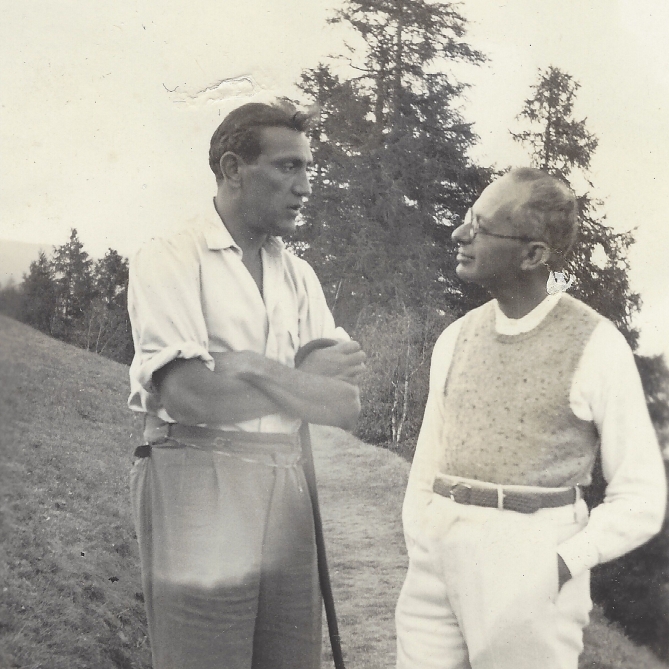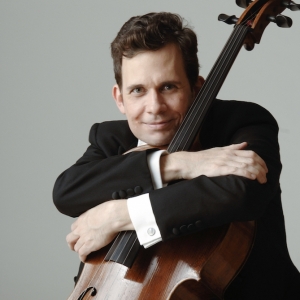
Exiles in Paradise: on the “Hollywood Renaissance” and Finding New Repertoire for the Cello: Part 2
Brinton Smith
This article is the second installment in a two-part series
As we discussed in part 1, war and persecution in Europe created an unprecedented gathering of émigré musical talent in Los Angeles in the mid-20th century, including Jascha Heifetz, William Primrose, Artur Rubinstein, Otto Klemperer, Bruno Walter, and Lotte Lehmann. Of particular interest to cellists, Los Angeles in this era was also home to top cellists including Gregor Piatigorsky, Emanuel Feuermann (for the last several summers of his life), Kurt Reher, Eleanor Aller (Slatkin), Gabor Rejto, Edgar Lustgarten and Ray Kramer, to name just a few, and the hometown of future stars such as Paul Katz, Laurence Lesser and Nathaniel Rosen.
But perhaps most remarkably, Los Angeles was the home of arguably the greatest collection of composers to gather in a single city since late 18th century Vienna. Composers including Joseph Achron, Mario Castelnuovo-Tedesco, Hans Eisler, George Gershwin, Louis Gruenberg, Bernard Hermann, Erich Wolfgang Korngold, Ernst Krenek, Sergei Rachmaninoff, Miklós Rózsa, Arnold Schoenberg, Max Steiner, Igor Stravinsky, Alexandre Tansman, Ernst Toch, Franz Waxman, Kurt Weill, and Erich Zeisl represented almost every imaginable style and aesthetic.
Our newly released CD, Exiles in Paradise: Émigré Composers in Hollywood surveys some of these remarkable composers of this “Hollywood Renaissance” with unusual works and new transcriptions for cello and piano, ranging from Korngold to Schoenberg, from rare compositions by Toch and Gruenberg to a finger busting transcription of Waxman’s Carmen Fantasie. Our hope is to spark an interest in these extraordinary and, in some cases, neglected composers, and broaden the repertoire and technical boundaries of the cello. Towards this goal, we have been surveying these composers and the potential repertoire they left us for -or adaptable for- the cello.
We turn our attention now to the composers who earned a portion of their living from the Hollywood Studios. Because of this stigma, their concert music was often dismissed by critics as “movie music”, but the sounds we now associate with the golden age of film are actually the personal styles and musical traditions that Korngold, Waxman, Castelnuovo-Tedesco, Rozsa, Toch and other immigrants brought with them as they turned from concert compositions to this new genre of symphonic music. Only in the last few decades, as the restrictions on what constitutes ‘worthy’ concert music have been re-examined, has the true depth of genius of these composers begun to be recognized.
Louis Gruenberg’s (1884-1964, LA 1937-64) family, like those of Godowsky and Gershwin, immigrated in the late 19th century, fleeing persecution in Russia. Gruenberg gained rapid, but fleeting, fame in America with his 1933 Opera The Emperor Jones, even appearing on the cover of Time. Gruenberg ultimately turned to film composing, with several Academy award nominations and at least 39 film score credits. His work stopped in the 1950s, likely as a result of blacklisting. Fellow Beverly Hills resident Jascha Heifetz commissioned and recorded a violin concerto in 1944, marking a second high point in Gruenberg’s career as a composer of concert music and he continued composing prolifically for the remainder of his life.
Like Gershwin, Gruenberg was fascinated with incorporating jazz and ragtime influences into classical music. We chose to transcribe one of his three 1924 Jazzettes, originally for violin and piano, to represent this, and all three could work well for cello and piano, though he did also write a 1925 Poem for cello and piano, Op.19 as well as the memorably titled 4 Indiscretions for String Quartet, Op.20!
Ernst Toch (1887-1964, LA 1936-50, 58-64) was a Viennese Jew who taught himself to compose by studying the scores of Mozart quartets. Forced from his professorship in Mannheim by Hitler, Toch found refuge in Hollywood, where he scored music for films in relative obscurity (his music for the chase scene in Heidi is perhaps his best known score) and taught both music and philosophy at USC. Toch was a leading avant-garde composer in the pre-war years, and believed his music represented a ‘third way’ between serial music and traditional techniques, but in later life Toch abandoned polytonality in favor of a more traditional approach. Toch wrote a 1924 Concerto for cello and chamber orchestra that was debuted and performed more than 60 times by Feuermann (Feuermann also commissioned a second concerto in 1941, which was abandoned upon Feuermann’s death) and a 1929 Cello Sonata, Op.50, both in a unique modern idiom. The Three Impromptus for solo cello in Exiles were written in a more traditional style, as a 60th birthday gift for Gregor Piatigorsky.
Mario Castelnuovo-Tedesco (1895-1968, LA 1940-68) was born in Florence and had already built his reputation as a classical composer in Europe, with commissions from Segovia, Heifetz and Piatigorsky and performances by Toscanini, when Mussolini’s racial laws drove him to emigrate to the US. Sponsored by Heifetz and Toscanini, Mario found work at MGM. During the remainder of his career he scored over 200 movies and taught numerous composition students, including Andre Previn, Henry Mancini and John Williams, while still continuing to compose concert works prolifically.
Castelnuovo-Tedesco composed quite a few works for the cello. The idea of reviving his 1935 Cello Concerto, commissioned by Piatigorsky and debuted with Toscanini and the New York Philharmonic, led to the predecessor to Exiles, a CD containing Castelnuovo-Tedesco’s cello concerto and arrangements of Mozart, Ravel and Rossini works that he made for Piatigorsky. Many cellists have played his well known comical variations on Figaro (available from Carl Fischer) but I also offer an alternative arrangement based more closely on Castelnuovo-Tedesco’s violin version here.
Exiles represents Castelnuovo-Tedesco with I Notambulli , which he described as “a set of extremely free and colorful variations, with a Spanish flavored theme,” written for Gaspar Cassado (also arranged for cello and orchestra) Castelnuovo-Tedesco also composed a Sonata, Op. 50 (1928), Chant Hébraique, Op. 53 (1928), Notturno sull’acqua, Op. 82/1 (1935), Scherzino, Op. 82/2 (1935) and a Toccata, Op. 83 (1935) which Piatigorsky frequently performed, as well as a the 1941 Meditation ‘Kol Nidre’ and a Valse on the Name of Gregor Piatigorsky, Op. 170/3
Miklós Rózsa (1907-1995, LA 40-95) was born in Hungary and trained in Leipzig. Rózsa began scoring films as a sideline to concert compositions. He sought refuge in Hollywood during World War II, and remained for the rest of his life. He is perhaps best known for Oscar winning scores such as Spellbound and Ben Hur, but he always continued his ‘double life’ as a classical composer. Rózsa’s Rhapsody for Cello and Orchestra, Op. 3 and the Duo for Cello and Piano, Op. 8 date from early in his career, while the Sinfonia Concertante for Violin, Cello and Orchestra, Op. 29 was commissioned by Heifetz and Piatigorsky (who only performed the middle movement, the Tema con variazioni, Op. 29a) Janos Starker commissioned and recorded his Concerto for Cello and Orchestra, Op. 32 and Rózsa wrote the Toccata capricciosa for solo cello in 1979, dedicated to the memory of Piatigorsky. In his mature works, Rózsa is known for the incredibly taxing technical demands of his string writing and his Toccata capricciosa is increasingly gaining popularity as a shorter (and perhaps even more difficult) alternative to the Kodaly solo sonata.
Erich Wolfgang Korngold (1897-1957, LA 1938-57) was perhaps the greatest child prodigy the music world has ever seen, famous throughout Europe while still a teenager. Mahler declared him a ‘genius’ at age 9 and Richard Strauss said he felt a sense of ‘awe’ reading through the 12 year old Erich’s compositions. By the time Korngold was in his young twenties, he would be one of the most successful composers in the world, with operas and concert works performed in concert halls throughout Europe. As critical tastes moved towards more astringent modernism, Korngold began to accept a few requests to score serious films.
When the Anschluss made his return to Vienna impossible, Korngold settled into a storied career as a film composer in Los Angeles. His 16 scores set a matchless standard for musical innovation and beauty, and his use of recurring leitmotifs for major characters remains deeply influential in film music to this day. When the war ended, Korngold left film composing and attempted to restart his concert music career. However, despite composing many great works, including his now beloved violin concerto, Korngold failed to impress the modernist tastes of the era’s musical elites and died nearly forgotten.
Though he left some astounding chamber music, Korngold’s wrote little for the cello as a solo instrument until his score for the 1946 film noir Deception, centered around a musical love triangle, featured a newly composed cello concerto in its climax. Korngold slightly expanded the soundtrack material into a 13 minute Concerto in One Movement, Op.37, debuted by the excellent soloist of the soundtrack Eleanor Aller (Slatkin) There is also a short unpublished Romance Impromptu for cello and piano written for, but cut from the movie. Korngold had a magical gift for vocal writing and many of his songs work beautifully on the cello, particularly Marietta’s Lied and Pierrot’s Tanzlied from Die tote Stadt. For Exiles we transcribed his 1920 Suite for Violin and Piano of music written for a production of Much Ado About Nothing
Franz Waxman (1906-67, LA 34-67) was born in Germany, studied in Dresden and had an early start in the German film industry, orchestrating the score for The Blue Angel when he was only 24 years old. A severe beating by Nazi thugs in 1934 convinced Waxman to leave Germany and he settled in Los Angeles, where his scores for films such Bride of Frankenstein, Rebecca, and Rear Window earned him twelve Academy Award nominations, and two Oscars in consecutive years, for Sunset Boulevard and A Place in the Sun. Waxman also composed concert works and, in 1947, founded the Los Angeles Music Festival with the goal of bringing European concert standards to the thriving town. Programs often paired adventurous new music with classics, and championed the works of fellow composers.
Waxman wrote little for cello, though at the time of his death he was working on a cello concerto commissioned by Pierre Fournier. Only the four minute Introduction and Scherzo was completed. However cello transcriptions of his Four Scenes of Childhood for violin, an Elegy from The Story of Ruth and the Carmen Fantasie composed for 1946 film Humoresque (and popularized in concert performances by Heifetz,) are available from FranzWaxman.com
We recorded the Carmen Fantasie, slightly modifying the transcription of David Grigorian to follow the violin version more exactly. This piece simultaneously compelled me with its wit and genius and rebuffed me with its insanely unplayable passagework. Recommended for masochistic cellists everywhere…
The depth of talent in Los Angeles during that era was so substantive that even this detailed survey leaves the music of many great composers still undiscussed. In particular, Ernst Krenek and Alexandre Tansman wrote many smaller works the cello and Kurt Weill and Erich Zeisl both composed cello sonatas
We close Exiles in Paradise with It Ain’t Necessarily So from Porgy and Bess, in my adaptation of Heifetz’s fantastic transcription. Born Jacob Gershowitz to recently arrived Lithuanian immigrants, Gershwin was raised in a household speaking Yiddish and Russian. This child of immigrants who grew up to personify the idiom of American music seemed the appropriate ending to our survey. It is humbling to consider how much of America’s scientific, economic and cultural inheritance in the 20th century flowed from those who came seeking refuge, opportunities and fair treatment that their own governments would not afford them. These composers transformed the musical culture of America in ways that are only now beginning to be fully appreciated, and left a legacy of beautiful works for the cello that deserve a place in our programs. I hope you will enjoy your explorations as much we have!
Subjects: Historical, Repertoire
Tags: korngold, Piatagorsky, Rosza
